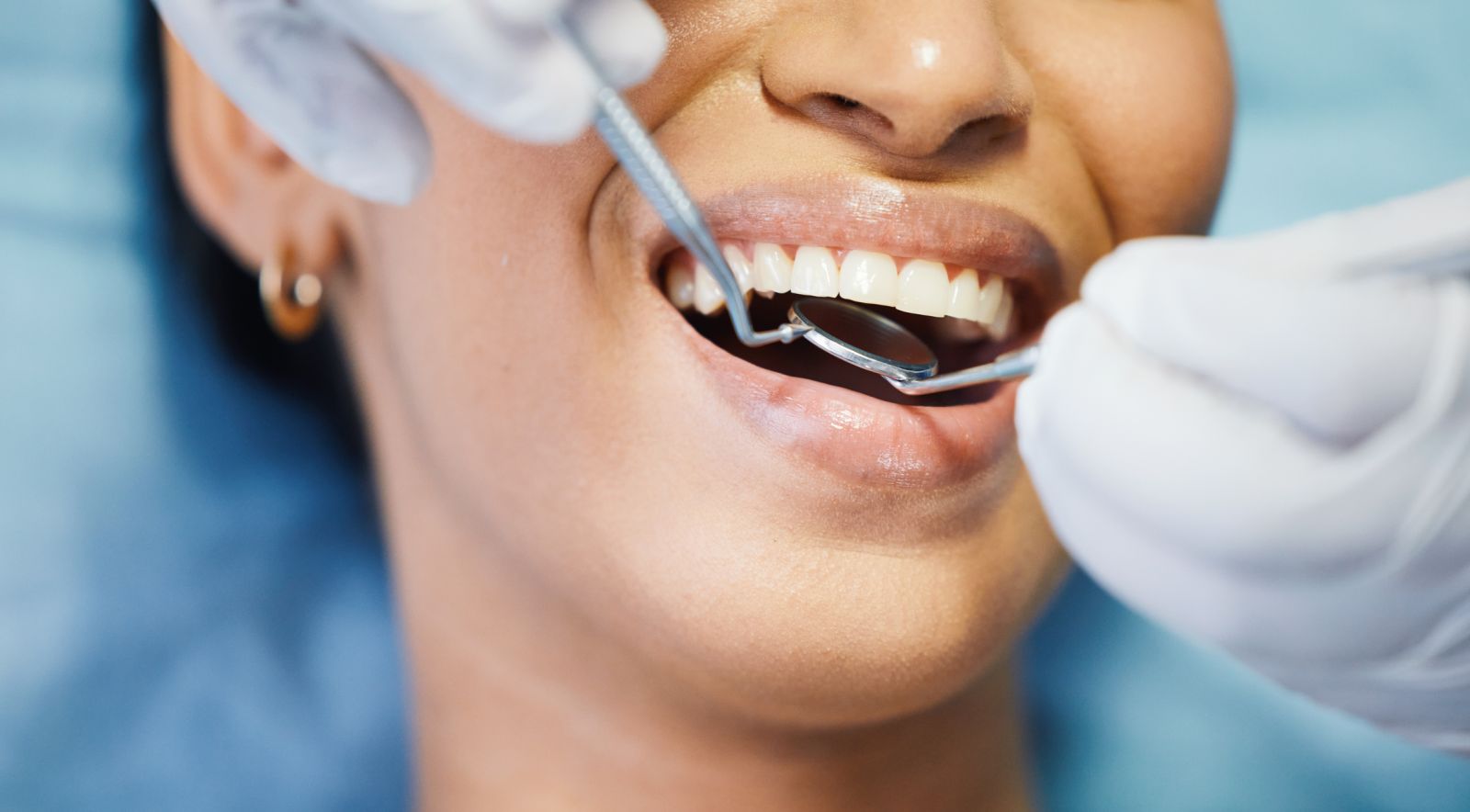Diabetes and Dental Care: Taking Care of Your Teeth
By Hope Warshaw
 Having diabetes along with years of high glucose levels can cause problems with your teeth and gums. Know what dental problems could occur, what to do about them, and how to prevent them.
Having diabetes along with years of high glucose levels can cause problems with your teeth and gums. Know what dental problems could occur, what to do about them, and how to prevent them.
People with diabetes, particularly those who over time have higher than recommended blood glucose levels, are at greater risk of developing dental problems, most commonly gum disease and loss of teeth. In fact, research shows that it is common for dentists to detect that a person has prediabetes or diabetes.
Here is a list of self-care habits that can help you keep your teeth and gums healthy, as well as guidance on when and how often to seek dental care to prevent or treat problems you encounter.
Basics of diabetes-related dental problems
Simply having diabetes does not set you up for dental problems; it’s having elevated glucose levels over time that sets the potential for dental problems into motion. As is the case with other long-term diabetes complications where one problem can lead to another in the absence of blood glucose management, preventive self-care, and regular checkups, the same is true for tooth and gum problems.
Higher blood glucose levels can decrease the amount of saliva in your mouth and change its contents. Saliva, the fluid that keeps the mouth moist, is produced in the salivary glands located in and around the mouth. Saliva helps you chew and swallow foods and beverages, and helps prevent damage to the teeth and gums from harmful bacteria.
High glucose levels feed harmful bacteria that form an unhealthy coating on teeth. This coating is plaque, which can cause cavities and gum irritation because it builds up on the teeth near the gum line. If you don’t remove this plaque with regular brushing and dental cleanings, it hardens into tartar, and if this build-up of tartar is not removed with regular dental cleanings, it will eventually lead to gum disease.
Common dental problems with diabetes
-
Cavities are areas of decay on the surface of teeth that lead to tiny openings in the tooth. It is the most common dental problem. To prevent the openings from growing, cavities should be cleaned out and filled with a material that hardens.
-
Gum disease, also referred to as periodontal disease, is the most concerning dental problem seen in people with diabetes. According to the ADA Standards of Care people with diabetes tend to have periodontal disease that is more prevalent and severe and is typically associated with higher A1C levels. The first stage is inflamed gums, also known as gingivitis or inflammation. It develops due to the buildup of plaque and tartar at the gum line. The gums may become noticeably red and swollen, and may bleed easily. If left untreated, gingivitis can progress to periodontitis. This is an infection of the gums and bones, which if left untreated, can cause teeth to loosen.
-
Dry mouth can be caused by high glucose levels, as well as certain medications and stress. Simple self-care strategies to manage dry mouth are: staying hydrated by drinking water or other sugar-free liquids, chewing sugarless gum or using lozenges, and maintaining good dental care.
-
Thrush (oral candidiasis) is a fungal infection that causes painful, creamy white patches on the tongue or inner cheeks of the mouth. High glucose levels can lead to excess sugar in the saliva, creating an ideal environment for this fungus to thrive.
-
Burning mouth syndrome is a scalding or tingling feeling in the mouth that may also be accompanied by numbness, dry mouth, or altered sense of taste. This can be challenging to diagnose.
Signs and symptoms of dental problems
 The following are signs and symptoms that may be a warning that you have dental and/or gum problems.
The following are signs and symptoms that may be a warning that you have dental and/or gum problems.
-
Gums that appear red and swollen or are bleeding
-
Gums that appear to be pulling away from teeth (referred to as receding gums)
-
Loose teeth
-
Spaces between teeth that increase in size
-
A feeling of dryness in the mouth, which can be a sign of high glucose levels and new-onset diabetes
-
Bad breath that is not improved by regularly brushing teeth
There is value to detecting oral health issues as soon as possible.
Before her diagnosis with early-stage periodontal disease during a routine dental cleaning, Lizzette Kopco was not aware of the connection between diabetes and dental problems.
“Though my gums bled a lot when I flossed my teeth, I was told only that high sugar levels could cause problems if they were left untreated or not well-managed for too long,” said Kopco, a biologist, podcaster, and diabetes community advocate who has lived with type 2 diabetes for 9 years. By the time she discovered she had periodontal disease, the condition had already progressed.
How to prevent diabetes-related dental problems
As is true for the prevention or delay of most diabetes-related problems, there are actions to take daily to prevent dental problems, like doing daily dental care and keeping glucose, blood pressure, and lipids well managed. There are also actions to take annually or more frequently, if needed; these are to get preventive care and follow up for any problems.
Daily actions
-
Get and keep glucose levels in a desired target range. Good glucose management over time can help reduce the risk of or slow the progression of dental problems. Work with your diabetes health care providers to come up with a target range for your blood glucose that is best for you.
-
Brush teeth at least twice a day with fluoride toothpaste. Better yet, brush your teeth after every time you eat. Use a toothbrush with soft bristles.
-
Floss teeth at least once a day. Flossing more often or after every time you eat is better.
-
Check your gums regularly for signs and symptoms of dental problems.
-
Limit the consumption of sugary foods and beverages. If you consume foods and beverages high in added sugars, try to brush and floss your teeth afterwards.
-
Do not smoke, or if you do, quit smoking. Smoking or the use of other tobacco products can increase the risk of getting gum disease. Get help quitting by calling the National Quitline at 1-800-784-8669, or visit smokefree.gov.
Annual or as-needed actions
-
Get your teeth cleaned, X-rayed, and inspected by a general or family dentist at least once a year. This is thought to be a good practice for everyone. The ADA recommends that when you’re diagnosed with diabetes you see a dentist for a comprehensive dental and periodontal exam. (Use of dental settings as a healthcare setting that could be used for diabetes screening has been explored, but no recommendation has been made to encourage implementation at this point.) Typically, a dental hygienist in the dental office will do the cleaning and take the X-rays. The dentist will review your X-rays and inspect your mouth, including doing an additional exam for signs of oral cancer. You will be informed if you need follow-up care or you should have your teeth cleaned more frequently. Let these healthcare providers know you have prediabetes or diabetes. Do not expect your primary or diabetes care providers to ask you about your dental health.
-
Make your next dentist appointment at the end of the current appointment. Alternatively, put a reminder in your calendar to make your next appointment.
-
Follow up on any problem identified or recommendation made at your dental cleaning and checkup. For example, your dentist might recommend that you get a cavity filled or see a specialist for a procedure or further evaluation. There are specialists with advanced training in several areas of dentistry. Perhaps your general dentist has identified areas in your mouth where your gums are receding. Your dentist might refer you to a periodontist. If you need a root canal, your dentist may refer you to an endodontist.
-
Learn about the common dental problems that occur in people with diabetes and their signs and symptoms. Tell your dental hygienist and dentist about any signs and symptoms you may have. Share general information about your current glucose levels and diabetes management. If you have had a problem with your teeth and gums, ask the dentist whether you should have your teeth cleaned and inspected more often than once a year.
 If you need extensive dental work that will require surgery, not eating for hours, and/or the need to eat only soft foods for a period of time, remind the dentist doing the procedure that you have diabetes. Let the dentist know what glucose-lowering medications you take and if your medications can cause hypoglycemia. Discuss how to manage these medications before and after surgery. Ask to schedule your procedure for the first thing in the morning. You may also want to discuss this with your diabetes health care providers to work out an optimal plan.
If you need extensive dental work that will require surgery, not eating for hours, and/or the need to eat only soft foods for a period of time, remind the dentist doing the procedure that you have diabetes. Let the dentist know what glucose-lowering medications you take and if your medications can cause hypoglycemia. Discuss how to manage these medications before and after surgery. Ask to schedule your procedure for the first thing in the morning. You may also want to discuss this with your diabetes health care providers to work out an optimal plan.
Low-cost dental care
If you cannot afford dental care or don’t have dental insurance, consider free or low-cost dental care. There are some options available through your state’s Medicaid program and Children’s Health Insurance Program (CHIP), community health centers and services, or dental or dental hygiene training programs. Traditional Medicare does not cover most dental services, but dental care may be covered by some Medicare Advantage plans.
Due to COVID-19 restrictions and a lack of access to affordable dental care, Kopco’s periodontal disease progressed to stage 2, which required deep cleaning below gums and antibiotics. To slow the progression of the disease, Kopco now brushes her teeth with a prescription-strength fluoride toothpaste and flosses daily. She has begun getting routine dental cleanings every three months, and she makes sure to follow up with her dentist if anything seems out of the ordinary.
Based on her experience, Kopco has some advice: Other people with diabetes should become knowledgeable about the connections between high glucose levels and diabetes complications, do the recommended daily self-care, and schedule regular cleanings. She adds: “Know that your daily self-care efforts matter.”
Recommendations in this article are aimed at adults with type 1 and type 2 diabetes and exclude children and adolescents as well as pregnant people with diabetes. Discuss your targets with your healthcare providers; recommendations may vary based on a number of personal factors.
Other articles in this series:








